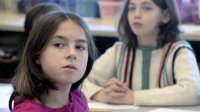Teaching Global Competence
The benefits of promoting cultural diversity, tolerance, and empathy in curriculum to foster global awareness.
Overview
Teaching Global Competence
Founded with a vision to prepare students for a globalized future, Seattle's John Stanford International School (JSIS) is an internationally themed, model public elementary school.
JSIS seeks to teach students to be global citizens while raising academic performance. This is done through language immersion in Spanish or Japanese for half the day -- teachers conduct the other half of the day in English. In addition, the focus of the global curriculum is not just to talk about social issues, like a lack of potable water, but to do something about these problems.
It takes special teachers to work at JSIS. Teachers must be experienced in international education; have language skills; participate in professional-learning-communities (PLCs); and, most important, be lifelong learners.
How It's Done
How to Encourage Global Perspectives in Your Students
Build On What You Care About
"You can take any unit and change it a little so that students really start to see the world globally," explains fourth-grade teacher Nicole Silver. She described one of her units called Festivals of Light (PDF). "A more traditional unit might have been: Learn about three holidays. Instead, I wanted students to think about the need for tolerance in the world," Silver explains. She has students choose a winter festival from anywhere in the world, then raise questions through the inquiry process, conduct research, and think critically about issues of religious tolerance. During the unit, Silver encourages students to consider their own feelings and think about whether they have ever felt like an outsider. She takes the discussion deeper by asking students, "What was it like to not fit in?" And, as an action step, "How do we welcome everyone?"
Hiromi Pingry, who has been at JSIS for ten years and teaches Japanese, math, science, and social studies, constantly challenges herself to connect language lessons to global issues. "How can I expand from teaching about the culture of Japan to a more globalized view?" she wonders. In the past, for instance, a unit about the rainforest might have focused on animals and habitats. "Now, we dig into a global issue like deforestation," she says. To infuse language study into science, she has connected her students with people from Japan who are working on environmental issues in Africa. For teachers new to global education, she advises, "Start with something that you find interesting, something you have a passion for. Build global perspective from that."
Harness Parent Power
At the start of each year, kindergarten and first-grade teacher Julie Colando surveys parents about their careers. If their work takes them outside the United States, she invites them to share their experiences with students. "These bring to mind mini-TED talks," Colando says, but geared for audiences of five- and six-year-olds. Parents have given classroom presentations and hands-on demonstrations about everything from oceanography research to vaccines to sanitation in the developing world. One parent, working on clean-water issues, opened his chat by showing photos of homes around the world. He simply asked students what they noticed. Next, they compared images of food from around the world. Then, toys. Then, toilets. "The way he did it was not guilt-inducing," the teacher observed. "It got students thinking about, 'What if you couldn't wash your hands? What if there were no bathrooms? What might happen to your drinking water?'"
Keep It Fresh
Silver changes her curriculum every year. "That keeps it fresh for me," she says, and also allows her to connect with students' experiences. She starts each school year by taking time to find out, "Where are my students from? What are their prior experiences?" If students are immigrants or English-language learners, what can they teach their American-born classmates about other cultures? Keeping it fresh also allows Silver to respond to global events. During last year's election season, for instance, her students took part in their own mock election. They also investigated voting rights around the world and evaluated information sources for reliability. Regardless of topic, Silver asks thought-provoking prompts such as: "What's the world like outside my experience? How could I find out? How can we listen to and learn from others?"
For more suggestions about teaching students to become citizens of the world, download a free copy of Educating for Global Competence: Preparing Our Youth to Engage the World (PDF) by Veronica Boix Mansilla and Anthony Jackson. After JSIS teachers discussed the book as a staff, they were better prepared to plan units that emphasize principles such as teaching students to recognize and express their own perspectives, examine the perspectives of others, and act in ethical and creative ways to improve the world.
John Stanford International School
Enrollment
460 | Public, UrbanPer Pupil Expenditures
$6062 School • $11351 District • $9733 StateFree / Reduced Lunch
7%DEMOGRAPHICS:
4% English-language learners
4% Individualized education programs
